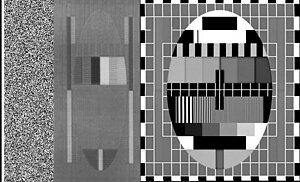

B-MAC[1] is a form of analog video encoding, specifically a type of Multiplexed Analogue Components (MAC) encoding. MAC encoding was designed in the mid 80s for use with Direct Broadcast Satellite systems. Other analog video encoding systems include NTSC, PAL and SECAM. Unlike the FDM method used in those, MAC encoding uses a TDM method. B-MAC was a proprietary MAC encoding used by Scientific-Atlanta for encrypting broadcast video services; the full name was "Multiple Analogue Component, Type B".
B-MAC uses teletext-style non-return-to-zero (NRZ) signaling with a capacity of 1.625 Mbit/s. The video and audio/data signals are therefore combined at baseband.
- Both PAL (626/50) and NTSC (525/60) versions of B-MAC were developed and used.
User base (PAL/NTSC zones)
- This system was used in South Africa[2] and Australia[3] (for TVRO until 2000).
- B-MAC was used for satellite broadcasts of the American Forces Radio and Television Service from the early 1980s until 1996-1997 when the analogue standard was replaced by the digital PowerVu system.[4]
- B-MAC has not been used for DTH applications since Primestar switched to an all-digital delivery system in the mid-1990s.
- ^ Report 1074-1 - Satellite transmission of multiplexed analogue component (MAC) vision signals (PDF). ITU. 1990. p. 48.
- ^ Conradie, D.G. (19 June 1988). "The SABC's TV/radio satellite distribution system". COMSIG 88@m_Southern African Conference on Communications and Signal Processing. Proceedings. pp. 51–55. doi:10.1109/COMSIG.1988.49301. ISBN 0-87942-709-4. S2CID 131163463 – via IEEE Xplore.
- ^ "8.3 Multiplexed Analogue Components Transmissions". happy.emu.id.au.
- ^ "Scientific-Atlanta's PowerVu Technology Helping AFRTS Expand the Delivery of A Touch of Home to Military Abroad" (Press release). Atlanta, GA: Scientific Atlanta. PR Newswire. Retrieved 2014-05-29.